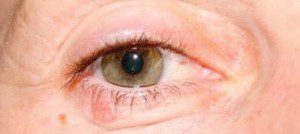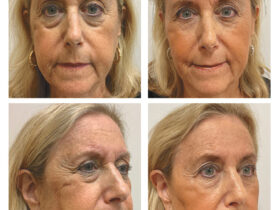With Nadia A. Kazim, M.D., F.A.C.S. –
 Eyelid cancer is not something most people often think about but they should. With their thin, delicate structures, the eyes and surrounding areas are particularly prone to cancers, and it’s an area people often forget to protect from the sun.
Eyelid cancer is not something most people often think about but they should. With their thin, delicate structures, the eyes and surrounding areas are particularly prone to cancers, and it’s an area people often forget to protect from the sun.
The eyelids can develop the same range of skin cancers as other parts of the body. Cancer occurs when the cells in a certain area of your body divide and multiply too rapidly. This produces a lump of tissue known as a tumor.
Eyelid cancer happens when the cells in the eyelids grow more quickly than normal.
Most eyelid cancers develop in people of middle age or older, but today they are becoming more common in younger people too.
The lower eyelids are the most common site of eyelid cancers, but any skin around the eye area can be affected.
The eyelids can also develop cancers arising from structures inside the lid, such as oil and sweat glands.
The sooner eyelid cancer is diagnosed as with all cancers, the easier it will be to treat successfully.
Risk Factors:
The primary risk factor for eyelid cancer, with the exception of sebaceous gland carcinoma, is excessive exposure to sunlight.
Older people are affected more often because they have had more exposure to the sun’s UV rays. Fair skin is also a big risk factor because fair skin provides little natural protection against the sun. Hereditary risk factors may also be a factor.
Early Warning Signs:
. A lump or bump that frequently bleeds or does
not disappear.
. Persistent red eye or inflammation of the eyelids
that does not respond to medication.
. Lesions that have irregular borders and growth.
. Unexplained loss of eyelashes.
Basal Cell Carcinoma:
Basal cell carcinoma, also known as BCC, is by far the most common type of eyelid cancer. They typically grow over months or even years, and are not highly malignant, meaning that they do not tend to spread around the body and almost never threaten patients’ lives.
However, they can cause significant distortion of the eyelids and eventually irritate the eye, or affect the vision or eye movements, so they should ideally be treated while still small.
Squamous Carcinoma:
These tumors, also known as SCCs, are less common and more malignant than BCCs.
It is unusual for them to spread to affect the rest of the body. However, they may invade nearby tissues and spread to the lymph nodes in the head and neck.
Their appearance varies from red, flattish patches that may be flaky or scaly.
Sebaceous Carcinoma:
Sebaceous carcinoma is one of the rarest cancers of the eyelid, but also one of the most malignant. It starts in the oil-secreting glands. These tumors can be difficult to diagnose because they often appear as nodules in the lids and often mistaken as a stye in the eye.
Sebaceous carcinoma is one of the eyelid cancers most likely to spread to the lymph nodes and beyond. People diagnosed with this tumor should therefore have investigations to check for spread of the cancer elsewhere in their body.
Melanoma:
Melanoma is the most serious type of skin cancer and can affect the eyelids. Although it represents less than 1% of eyelid cancers, this is the most serious of all eyelid cancers.
Melanomas start in the pigmented cells of the skin, and are more common in fair-skinned people and those who have had a lot of exposure to the sun.
Melanomas are usually treated by surgical excision, but additional treatments may be needed for tumors that have spread to other parts of the body.
Prevention:
Fortunately, preventing eyelid skin cancer can be easy – and fashionable. Sunscreens and moisturizers specially formulated for the eye area make wearing sunscreen daily on this sensitive skin much easier. Sunglasses are a must they not only make a chic fashion statement but also protects your eyes from the sun’s harmful ultraviolet (UV) rays.
Treating skin cancers of the eyelids poses special challenges since eyelids are composed of extremely specialized mobile skin. Dr. Kazim specializes in eyelid and facial surgery. Since the symptoms of eyelid cancer can vary greatly for each individual, it is all the more important to see a Doctor if you are experiencing any type of unexplained skin changes. A motto to live by when it comes to our health is when in doubt get it checked out immediately!
Dr. Nadia Kazim is an ophthalmic plastic surgeon and a proud member of the American Society of Ophthalmic Plastic and Reconstructive Surgery. She is board certified and fellowship trained. Her office is located in the Bonita Community Health Center in Bonita Springs, FL. Call or visit www.KazimEyelidSurgery.com for more information.









